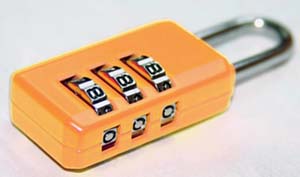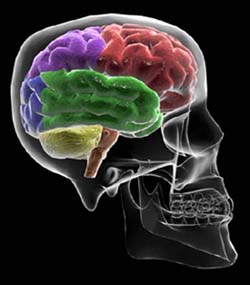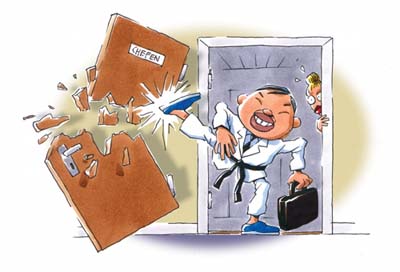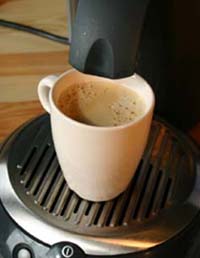
Remembrance of numbers past

Now what was that number again?
{\em In March 2004, Daniel Tammet from Kent set a new European record when he recited $\pi$ from memory to 22,511 decimal places. It took him five hours to complete the task, yet he had barely made it halfway to the world record of 42,195 digits set by Hiroyuki Goto of Japan in 1995.}
How do people pull off incredible (if rather pointless) memory feats like this? And is there anything we can learn from them when it comes to more practical needs for memorising numbers - like remembering the code on your padlock, or the PIN for your cashpoint card?
Memory and numbers
Memory is fundamental to the way you think, and you use it in almost every activity. You need memory to learn facts and names, but you also need it to acquire a new physical skill or even to tell a joke. Aptitudes vary enormously from one person to the next, but one person's ability to remember will also vary depending on the task. For example, somebody who has a good memory for numbers might be hopeless when it comes to remembering a joke (I speak from bitter experience here).
Where does the particular aptitude for remembering numbers come from? For reasons that I will explain in a moment, mathematicians are generally better equipped to remember numbers than other people, but it is certainly not essential to be a mathematician to have an exceptional ability in this area.

synaesthesia
Synaesthetists have a natural advantage when it comes to memory because the brain is more likely to record something in the long term when it ties in with the senses. An event or an object is more memorable when it has sounds, pictures, texture and particularly smell associated with it.

This way for memories
This link between memory and the senses is the basis of some of the memory techniques that are described in study-aids. One method that is often suggested for remembering numbers is to associate each digit with a rhyming word.
One is bun,
Two is shoe,
Three is tree,
Four is door,
and so on. The idea here is that an abstract number is turned into a tangible object, with all its associated images and sounds. If I wanted to remember the number 24, I could instead remember it as "shoe-door" and picture myself kicking down the front door (this image comes very readily to mind for some reason). The theory is that the memory of the kicking of the door will be retained for much longer than the number 24, so when I try to remember the number in a week's time, I will immediately think of the image and simply convert it back to the number I was trying to think of.

24, obviously
The mathematical approach to remembering numbers
Most people who are good at remembering numbers aren't so because of any sensory experience. It is much more likely to be because numbers have meaning for them. Mathematicians have a strong advantage here, because regular exposure to numbers means that the properties of numbers become familiar.
Show a mathematician the number 4832 and the chances are that they will immediately register what sort of number it is (four digits, divisible by two). Sometimes mathematicians can't help playing with the number, too. In this case, you may have found yourself saying 4832, four eights are thirty-two. This sort of play helps to give the number meaning, and to make it memorable.
There have been famous examples of this urge to play with numbers. Alexander Aitken was a professor of mathematics at Edinburgh University whose memory was renowned. He once commented:
If I go for a walk and a motor car passes and it has the registration number 731, I cannot but observe it is 17 times 43. ... When I see a bus conductor with a number on his lapel, I square it ... this isn't deliberate, I just can't help it. ... Sometimes a number has almost no properties at all, like 811, and sometimes a number, like 41, is deeply involved in many theorems that you know.

Now, which one is has the most interesting number?
Often, the patterns and meanings behind numbers will stick in the mind without effort, but if they don't, they can be the basis of a method for deliberately memorising a number. You might use them for remembering a PIN or a phone number, but they can apply to longer numbers too. For example, have a go at remembering this number. Give yourself about ten seconds:
15222936435057.
If you try to learn it by rote, you will probably struggle. Short term retention of a number is normally limited to seven digits. Any more than that, and you are unlikely to remember more than the first few digits. (In the above example, most people remember 15222 easily, but after that get increasingly muddled).
But now put on your mathematical hat. Can you spot a pattern within the digits that will make them much easier to remember? There's probably more than one way to simplify the task here, but there is one particular pattern which, if you spot it, makes the task trivial.
In fact the number can be broken into pairs of digits, 15 22 29 36 43 50 57, each pair being seven larger than the previous pair. Now all you need to remember is the starting number and the rule.
Remembering Pi
Not all numbers have such convenient patterns behind them, but within every number there are always subgroups of digits that have mathematical meaning. That even applies to $\pi$, whose digits are effectively a random sequence. \par Here are the first 100 digits of $\pi$: \begin{eqnarray*} 3.14159265358979323846264338327950288419716939937510\\ 5820974944592307816406286208998628034825342117067. \end{eqnarray*}
Most people would not be able to remember this as a sequence of single digits, but the task becomes easier if you pick out clumps of interesting numbers.
3.141592653589793238462643383...
For example, the first ten decimal places include the consecutive numbers 14-15, and then 65-35 which add to make 100. Later there is a cluster of even digits, 846-264. These are both simple series with the second two digits transposed (864 has become 846, 246 has become 264). Gradually you can build up a mathematical story that links these patterns together.
This is the sort of approach that professional memorisers use, though they often combine it with other techniques, for example, converting digits into letters which they then turn into words. A common digit-to-letters rule is as follows:
1 becomes the letter T (a single downstroke),
2 is n (two downstrokes),
3 is M (three downstrokes),
4 is R (r is the fourth letter of four!),
5 is L (L is the Roman fifty, which is close...),
6 is J (J is a bit like a backwards 6),
7 is K (K is like two sevens stuck together),
8 is F (a cursive f resembles an eight),
9 is P (P is a backwards 9),
0 is Z (Z is for zero).

planning a jail break
The start of $\pi$ now becomes M-T-R-T-L-P-N-J-L..., and if you insert a few vowel sounds (which don't count as digits) you might come up with, for example, {\bf My TuRTLe oPeN JaiL}. Picture your turtle opening a jail and, voila, the first nine digits of pi are memorised. Continue this for 42,187 more digits and the world record is yours.
Fortunately, unless you plan to become a memory performer, or decide to pursue some very specialised areas of physics, maths or astronomy, it is very unlikely you are ever going to need to remember $\pi$ to more than three or four digits. In which case there is a memorable sentence that is all you'll ever need when it comes to recalling this important number:

churning out digits of pi
Count the number of letters in each word of that sentence, and you'll see that the digits of $\pi$ are revealed to seven decimal places.
In the end, whatever number you want to remember, whether it is $\pi$, a historic date or the code of a padlock, the most memorable mnemonics are the ones that you invent for yourself. It really doesn't matter how quirky your approach is. If it works for you, that is all that matters.
About the author

Rob Eastaway is an independent lecturer, and a consultant to the Millennium Maths Project. He specialises in the everyday applications of mathematics. His books include "How to Remember", which contains a chapter on memorising numbers. It is published by Hodder & Stoughton, priced £7.99.
Among his other books are "Why do buses come in threes?" and "How long is a piece of string?", both reviewed in past issues of Plus.